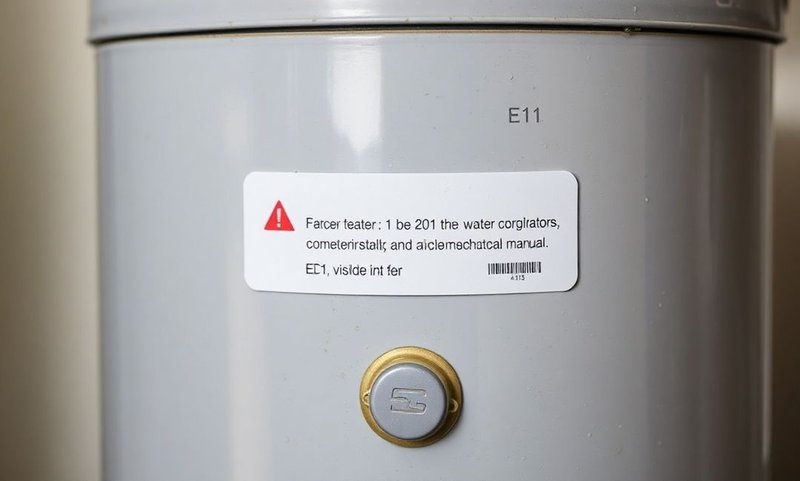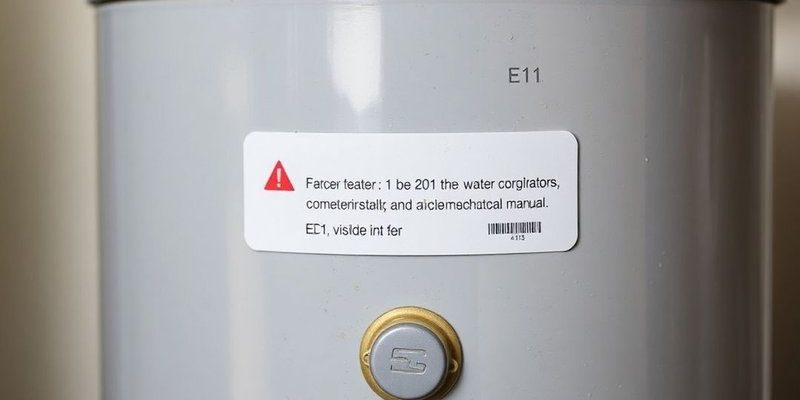
Imagine your water heater as a helpful, diligent friend. It works tirelessly to ensure you have hot water whenever you need it. However, like any overworked friend might, it sometimes gets into a bit of a pickle, and the E1 error is its plea for assistance. If you’ve never had to decode appliance error messages before, don’t worry—you’re not alone. Many beginners feel overwhelmed when faced with a blinking code. But here’s the deal: with a bit of friendly guidance, you’ll be navigating these waters like a pro.
Understanding the E1 Error Code
The E1 error code is a common issue with Bosch water heaters, signaling that there’s a problem with the heater’s ignition process. Essentially, it’s like when you try to start your car and hear that dreaded clicking sound—something’s not sparking as it should. This could happen due to various reasons, all of which affect your heater’s ability to heat water. Ignition problems can be a bit tricky, especially if you’re not exactly sure what’s causing the hiccup.
One potential cause could be an issue with the gas supply. Your water heater needs a steady flow of gas to ignite properly, and any disruption can lead to the E1 error. Picture your gas supply like a hose—if there’s a kink or blockage, the water (or in this case, gas) can’t get through. Similarly, any obstacles in the gas line or low gas pressure can cause problems with ignition.
Another factor might be a faulty igniter. Think of this as the spark plug of your water heater; it creates the initial spark needed to ignite the gas. If the igniter is worn out or damaged, it’s like trying to start a fire with damp matches—ineffective and frustrating. Occasionally, it’s also a simple case of wiring issues or loose connections within the system. Loose wires can disrupt the electrical signals required for the heater to function correctly. At this point, checking and securing connections could be your first DIY troubleshooting step.
Possible Solutions for E1 Error
Now, let’s talk about how you can address these issues. First, if you suspect a gas supply problem, it’s crucial to ensure that your gas valve is open and the supply is consistent. Sometimes, appliances like these can get a little moody if the gas lines haven’t been bled correctly after a refill. Give your gas valve a check to ensure it’s in the right position. And if you’re dealing with LP gas, make sure the cylinder isn’t empty—or close to it.
With igniter issues, a close inspection is necessary. If you’re comfortable with the task, you can remove the casing of your heater to take a look at the igniter. Is it clean and free of debris? It might just need a gentle wipe to get back in working order. Remember to always cut the power to the unit before attempting this, since safety should always come first.
For wiring troubles, it might be a matter of tightening any loose connections you find. Imagine this as a loose shoelace needing a quick knot; a secure connection ensures that electricity flows smoothly, allowing your heater to work its magic. If all this sounds a bit daunting, or if inspecting these parts doesn’t solve the problem, it might be wise to call in a professional. A trained technician can provide a more thorough check and ensure everything is in top shape.
Preventative Measures and Maintenance
To keep your Bosch water heater running smoothly, regular maintenance is key—kind of like visiting the dentist for a routine check-up. Regularly inspect the gas lines for clogs or wear, as these are often overlooked but crucial for smooth operation. Checking the igniter and pilot light every few months can help catch potential issues early, just as you’d check your smoke detector batteries.
Ensuring proper venting and airflow around your heater is equally important. It’s like making sure a campfire has enough air to burn effectively. Poor airflow can lead to incomplete combustion, which can trigger an E1 error. Keep the area around your heater clean and clutter-free to ensure optimal performance.
If your heater is located in a cold area, consider insulating the pipes to prevent them from freezing during winter months. This simple step can save you from numerous headaches down the line and guarantee a steady supply of hot water regardless of the season.
In essence, treating your water heater with care and attention can help prevent the E1 error from cropping up. Doing so will not only extend its lifespan but also ensure that you always have the comfort of hot water at your fingertips when you need it the most. With these tips, you’ll be well on your way to becoming proficient in troubleshooting Bosch water heaters, turning what might have been a cold shower mishap into a warm success story.
